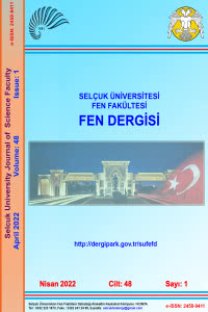Hurda Pazarından %5.25 Verimli Boya Duyarlı Güneş Hücrelerinin Üretimine Uzanan Bir Çalışma
A STUDY FROM JUNK MARKET TO THE PRODUCTION OF 5.25% EFFICIENT DYE-SENSITIZED SOLAR CELLS
___
- Bianchi, R. F., Panssiera, M. F., Lima, J. P. H., Yagura, L., Andrade, A. M., Faria, R. M., 2006, "Spin Coater based on Brushless DC Motor of Hard Disk Drivers", Progress in Organic Coatings, Vol. 57, No. 1, pp. 33-36.
- Downs, R. T., Hall-Wallace, M., 2003, "The American Mineralogist Crystal Structure Database", American Mineralogist, Vol. 88, pp. 247-250.
- El-Agez, T. M., Taya, S. A., 2014 "Design of a Spectroscopic Ellipsometer by Synchronous Rotation of the Polarizer and Analyzer in Oppositedirections", Microwave and Optical Technology Letters, Vol. 56, No. 12, pp. 2822–2826.
- Ellabban, O., Abu-Rub, H., Blaabjerg, F., 2014, "Renewable Energy Resources: Current Status, Future Prospects and Their Enabling Technology", Renewable and Sustainable Energy Reviews, Vol. 39, pp. 748–764.
- Fan, F., Liu, Z., Yin, L., Nichols, P. L., Ning, H., Turkdogan, S., Ning, C. Z., 2013, "Simultaneous Two- Color Lasing in a Single CdSSe Heterostructure Nanosheet", Semiconductor Science and Technology, Vol. 28, No. 6, pp. 065005.
- Fan, F., Turkdogan, S., Liu, Z., Shelhammer, D., Ning, C. Z., 2015, "A Monolithic White Laser", Nature Nanotechnology, Vol. 10, No. 9, pp. 796-803.
- Feldman, D., 2014, Photovoltaic (PV) Pricing Trends: Historical, Recent, And Near-Term Projections, https://escholarship.org/uc/item/06b4h95q
- Gratzel, M., 2003, "Dye-sensitized Solar Cell", Journal of Photochemistry and Photobiology C, Vol. 4, pp. 145– 153.
- Gevorkian, P., 2007, Sustainable Energy Systems Engineering: The Complete Green Building Design Resource, McGraw Hill Professional.
- Green, M. A., Emery, K., Hishikawa, Y., Warta, W., Dunlop, E. D., 2017, "Solar Cell Efficiency Tables (Version 49)", Progress in Photovoltaics: Research and Applications, Vol. 25, pp. 3-13.
- IEA, 2014, Technology Roadmap: Solar Photovoltaic Energy.
- Jose, R., Thavasi, V., Ramakrishna, S., 2009, "Metal Oxides for Dye‐Sensitized Solar Cells", Journal of the American Ceramic Society, Vol. 92, no. 2, pp. 289-301.
- Ji, I., Park, M. J., Jung, J. Y., Choi, M. J., Lee, Y. W., Lee, J. H., Bang, J. H., 2012, "One-dimensional Core/Shell Structured TiO 2/ZnO Heterojunction for Improved Photoelectrochemical Performance", Bulletin of the Korean Chemical Society, Vol. 33, No. 7, pp. 2200-2206.
- Shankleman, J., Martin, C., 2017, "Solar Could Beat Coal to Become the Cheapest Power on Earth". Bloomberg View, Bloomberg LP, Retrieved 3 January 2017.
- Kilic, B., Omay, D., Kosa, E., Trabzon, L., Kizil, H., 2012, "Growth of ZnO Nanostructures on Biopolymer Films", Journal of Materials Science and Engineering A, Vol. 2, No. 12A, pp. 761.
- Kılıç, B., Çelik, V, 2015, "Self-assembled Growth of Tandem Nanostructures based on TiO2 Mesoporous/ZnO Nanowire Arrays and Their Optoelectronic and Photoluminescence Properties", Applied Physics A, Vol. 119, No. 2, pp. 783-790.
- Kilic, B., Turkdogan, S., Astam, A., Ozer, O. C., Asgin, M., Cebeci, H., Urk, D., Mucur, S. P., 2016, "Preparation of Carbon Nanotube/TiO2 Mesoporous Hybrid Photoanode with Iron Pyrite (FeS2) Thin Films Counter Electrodes for Dye-Sensitized Solar Cell", Scientific Reports, Vol. 6, pp. 27052.
- Levelized Cost and Levelized Avoided Cost of New Generation Resources, US Energy Information Administration, Annual Energy Audit 2016, 5 Aug. 2016.
- Parida, B., Iniyan, S., Goic, R., 2011, “A Review of Solar Photovoltaic Technologies”, Renewable and Sustainable Energy Reviews, Vol. 15, no. 3, pp. 1625-1636.
- Scriven, L. E., 1988, "Physics and Applications of Dip Coating and Spin Coating", In MRS Proceedings, Vol. 121, pp. 717.
- Sun, S., Gao, L., Liu, Y., 2010, "Enhanced Dye-Sensitized Solar Cell using Graphene-TiO2 Photoanode Prepared by Heterogeneous Coagulation", Applied Physics Letters, Vol. 96, No. 8, pp. 083113.
- Turkdogan, S., 2012, Nanowire Synthesis and Characterization: Erbium Chloride Silicate and Two Segment Cadmium Sulfide-Cadmium Selenide Nanowires and Belts, Master Thesis, Arizona State University, Electrical Engineering, Tempe.
- Turkdogan, S., 2015, Growth and Characterization of Multisegment Chalcogenide Alloy Nanostructures for Photonic Applications in a Wide Spectral Range, PhD Dissertation, Arizona State University, Electrical Engineering, Tempe.
- Turkdogan, S., Fan, F., Ning, C. Z., 2016, "Color‐Temperature Tuning and Control of Trichromatic White Light Emission from a Multisegment ZnCdSSe Heterostructure Nanosheet", Advanced Functional Materials, Vol. 26, No. 46, pp. 8521-8526.
- Yang, N., Zhai, J., Wang, D., Chen, Y., Jiang, L., 2010, "Two-dimensional Graphene Bridges Enhanced Photoinduced Charge Transport in Dye-Sensitized Solar Cells", ACS Nano, Vol. 4, No. 2, pp. 887-894.
- Yang, Z., Liu, M., Zhang, C., Tjiu, W. W., Liu, T., Peng, H., 2013, "Carbon Nanotubes Bridged with Graphene Nanoribbons and Their Use in High‐Efficiency Dye‐Sensitized Solar Cells", Angewandte Chemie International Edition, Vol. 52, No. 14, pp. 3996-3999.
- ISSN: 2147-9364
- Yayın Aralığı: 2
- Başlangıç: 2013
- Yayıncı: Selçuk Üniversitesi Mühendislik Fakültesi
YENİ BİR YÜKSEK HIZLI KALP DESTEK POMPASININ SAYISAL VE DENEYSEL ANALİZİ
Kaya Yüzey Renklerinde Bozuşma Sonucu Oluşan Değişimin İncelenmesi
A FAST BISECTION BASED ANALYZER DESIGN FOR THE DETERMINATION OF MODES IN CIRCULAR WAVEGUIDES
Porselen Atık Takviyeli Epoksi Kompozitlerinin Tribolojik Özelliklerine Vakum Uygulamasının Etkisi
Nurcan ÇALIŞ AÇIKBAŞ, Gökhan AÇIKBAŞ, Bilge YAMAN
Dairesel Dalga Kılavuzlarının Modlarını Belirlemede İkiye Bölme Temelli Hızlı Bir Analizör Tasarımı
Grafen Oksit Kabukların Boyutlarına Göre Sınıflandırılması: Deneysel Çalışma
A STUDY FROM JUNK MARKET TO THE PRODUCTION OF 5.25% EFFICIENT DYE-SENSITIZED SOLAR CELLS
DÜŞEY MADEN KUYULARINDA BETON TAHKİMAT KALINLIKLARININ BELİRLENMESİNE YÖNELİK BİR TASARIM YAKLAŞIMI
Said Shahzada HUSSAİNİ, İHSAN ÖZKAN
Üç Boyutlu Çözüm Ağları için K-Means Kümeleme Tabanlı Şekil Araması
